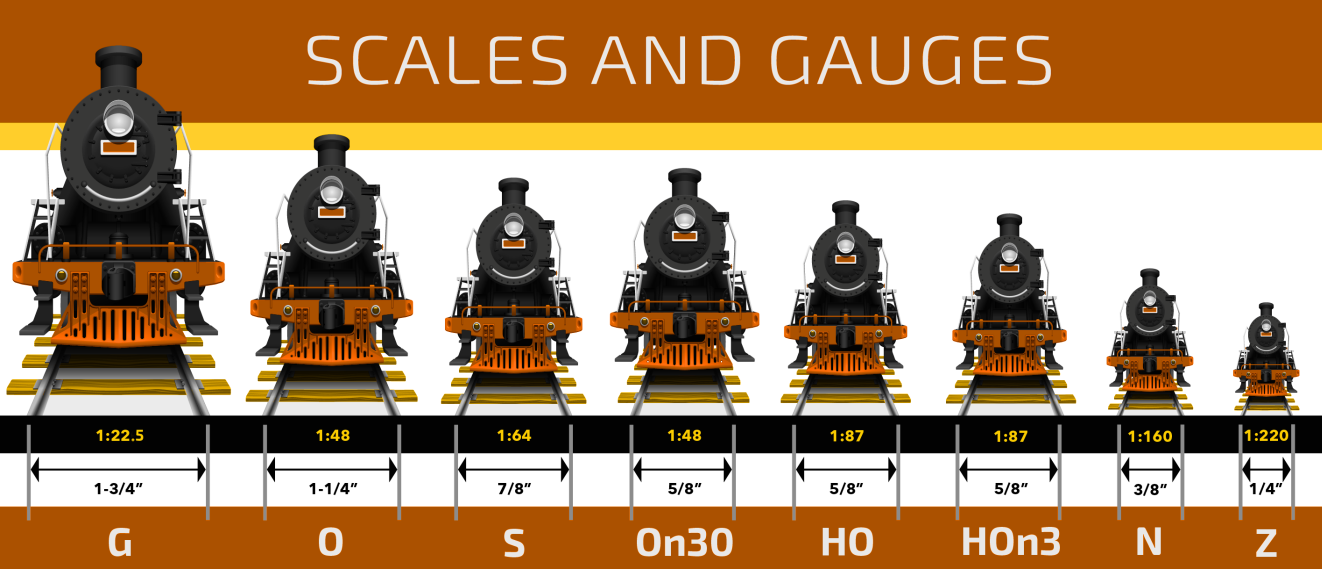
Understanding model railroad scales is the first step in choosing what kind of model you want to create. It will help lay the foundation for choosing the right equipment and planning your layout. Additionally, it is important to keep in mind the popularity of the scale you’re choosing. Certain scales will have more parts and accessories available to work with and purchase for your scenes. Let’s break down the different scales and their characteristics.
What is Scale?
Scale in model railroading refers to the ratio between the model and the real-world object it represents. A scale of 1:87, for instance, means that one inch on the model equals 87 inches in real life.
Common Model Railroad Scales
Z Scale (1:220):
The smallest scale, ideal for limited space.
Offers incredible detail in a compact layout.
Limited availability of rolling stock and accessories.
N Scale (1:160):
Popular for its balance of size and detail.
Well-suited for large layouts in smaller spaces.
An extensive range of models and accessories available.
TT Scale (1:120):
A middle ground between N and HO.
Growing in popularity, offering a good balance of detail and space.
HO Scale (1:87):
The most popular scale, offering a wide range of options.
Good balance of detail and size for most enthusiasts.
Enormous selection of models, accessories, and track.
S Scale (1:64):
Larger than HO, offering more detail.
Requires more space for a layout.
Growing in popularity, with a good range of models available.
O Scale (1:48):
Larger scale, providing impressive detail and presence.
Requires significant space for a layout.
Popular for its classic look and larger locomotives.
G Scale (1:22.5 to 1:32):
Largest scale, often used for outdoor layouts and garden railroads.
Focuses on visual impact and rideable trains.
Choosing the Right Scale
When choosing a scale, consider these factors and think through what you want to create. Doing this planning ahead of time will make your modeling process easier!
Available space: How much space do you have to work with? Your layout’s size will determine the suitable scale. Additionally consider how long you will be working on this layout and its potential to grow as you get more in depth.
Level of detail: Some scales offer more intricate details than others. If you like to create intimate scenes and love planning the little things in your layout, consider S Scale or smaller.
Cost: The availability of models and accessories for your scale of choice can influence costs. Think about where you will be able to get your accessories and what your budget is. The rarer the scale, the likelier you will be spending more money.
Gauge: While scale refers to the size of the model, gauge is the distance between the rails. Most common scales use standard gauge, but some use narrow gauge. Make sure you know ahead of time which gauge corresponds with which scale you’re choosing.
Era: Different scales are more suited to specific eras of railroading. If you have a specific era or scene you plan to make, research which scale makes the most sense for your needs.
Personal preference: Ultimately, choose a scale that excites you!
Once you understand these factors, you can confidently select the ideal scale for your model railroading journey.
"1" scale is missing. This is 1/32 scale. Very impressive detail and presence. Hard to set a layout at home.
I love this poster; do you have it available to purchase? Our historical society has a model train layout and I would love to have this for that room.
Sadly TT scale is not in the picture.
What is the difference between "O" and "O27" gauge model railroad?
I am trying to purchase a replacement train for our Xmas tree lobby. I am thinking of replacing it with a Lionel 0 gauge electric train. The existing tracks that we have now is; 12 pieces curves 11 inches each. 8 pieces straight 11 in inches. What Lionel train set should I purchase and how much extra tracks do I need to replicate the existing one? Help! Thank you
Question: I have 1:35 scale plastic model that want to use on a railroad set. What scale/gauge should I use?
Your track scale drawing above is incorrect for HOn3, skipped On3 and Sn3 altogether (while Sn3 is also gaining in popularity), Also, 7/8" is only close for S as 7/8" = .875," but S scale track is actually .882."
Thank you for the numbers. It is hard to get proper sized